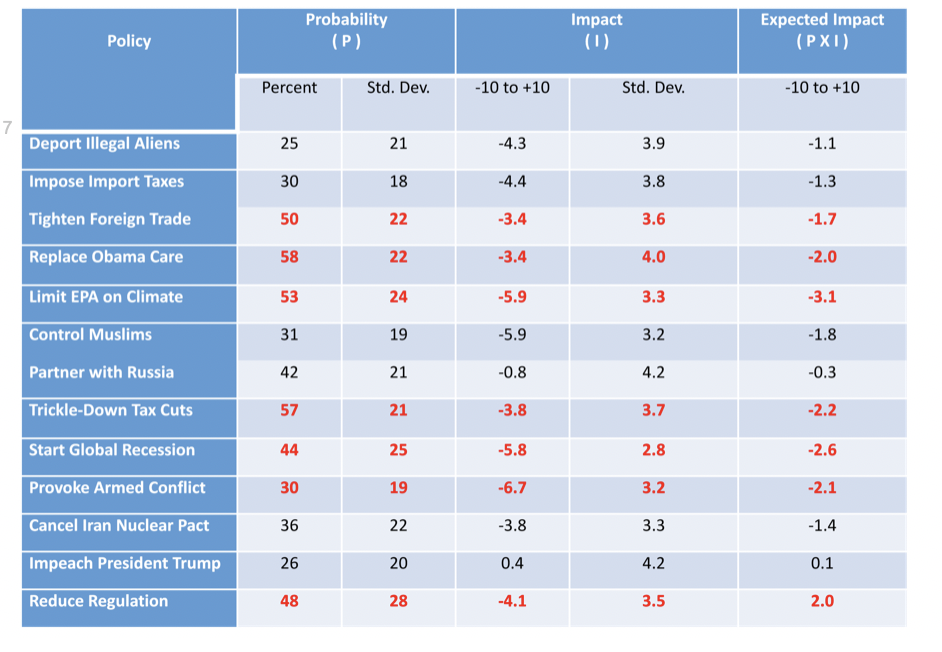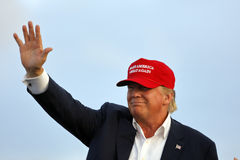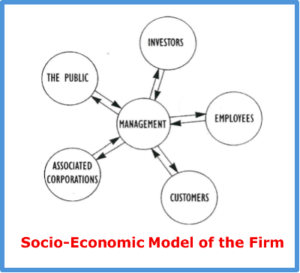This is a slightly updated version of our 2016 study forecasting the Trump Era.
The original study drew on the expertise of our global network of 150 international thought leaders. We realize that political issues are highly controversial, but the Trump presidency is one of the pivotal developments of our time, and we think it deserves objective research. This report includes a forecast of changes in Federal policies, a forecast of national performance, three alternative scenarios and comments from the respondents.
Based on all this data, here’s quick summary of what we forecast in 2016:
Growing Turbulence and Uncertainty
A striking result is the wide variation in expert estimates. Some are at opposite ends of the scales. We think this reflects powerful drivers of change and widely differing actors are now emerging. This also tells us there is a strong need for sound strategy, especially focusing on planning for crises and contingencies.
Major Change Plus Wild Cards
Our analysis suggests that most of these policies are moderately likely, while some are considered unlikely. The expected social impact is generally considered to be quite damaging. Signs of wild cards are seen in the prospects of an alliance with Russia and the impeachment of Mr. Trump; both are rated to have positive results.
Mediocre Performance
Our thought leaders also estimated various indicators of US national performance. They expect only modest economic growth, with Trump’s approval ratings likely to remain about 40 percent.
US National Policy Changes
We asked our experts to judge the likelihood that the federal government will deport illegal immigrants, impose tariffs or import taxes, curtail trade agreements, repeal the Affordable Care Act, muzzle the EPA, restrict Muslims, partner with Russia, reduce taxes on the wealthy, provoke a war, cancel the Iran nuclear accord, deregulate banks, and even impeach Mr. Trump. Here’s a quick summary of key themes that seem to be emerging from the data:

National Performance Forecasts
This table updates our 2016 forecasts by adding data for July 10, 2020. Note that most forecasts proved reasonably valid, except for the stock market gains.
| 2016 Forecast | 7/10/20 Actual | |
| Average GDP Growth/Year | 1.5 % | ~ 2 % until virus |
| DJIA Index | 21,000 | 26,000 |
| Trump Approval Rating | 39% | ~ 40% |
| Increase in Debt | $6.5 Trillion | $5.4 Trillion + |
Alternative Scenarios
Following are the forecasts made in 2016. We are considering updating these estimates and adding a fourth forecasting the 2020 election.
Trump Rules Probability = 50%, Impact = -.5 (-10 to +10)
President Trump inherits an economy that is extending its cycle of economic growth. Deregulation and lower taxes further boost business profits and provide gains for his supporters. Trump strengthens his hold on public opinion as a leader who gets things done. This allows him to run the nation like a corporation, treating allies as good team members and punishing enemies. Trump takes credit for successes and blames scapegoats for failures, while protests are smothered under dubious counter-claims and discredited. Congress goes along, encouraging him to dismantle much of the EPA and other disliked programs. By the end of his first term, Trump has transformed the US into a more purely capitalist and authoritarian society, somewhat isolated and in slow decline.
Trump Changes Probability = 27%, Impact = 3
Donald Trump is a brilliant strategist, and when the Congress shifts to Democratic control in 2018, he recognizes that his political survival requires a major change of course. As crises mount, his family and advisers press him to “pivot”’ toward being more traditionally presidential and cooperative. He modifies policies to appease critics, stresses the good progress he has made, and becomes more friendly, while continuing to confuse opponents with doubtful charges. The president is persuaded to yield on issuing incendiary tweets, and some opponents are even mollified by the Trump charm. Congress is pleased to see him appearing more reasonable, and Democrats approve the less controversial parts of his agenda. The US enjoys some prosperity and peace, although with occasional flare ups of political crisis and conflict.
Trump Falls Probability 39%, Impact = -1
The voices of protest become so persistent that they overwhelm Trump’s defenses, making his presidency untenable. The administration suppresses protests with force, causing violence to grow out of control and bringing normal life to a near halt. Enormous political pressures force Congress to work around Trump and assume effective leadership, with support from Vice President Pence and key Republicans. The rest of the world goes on while the US struggles with this constitutional crisis. Global agreements stall, and the world becomes increasingly chaotic. China becomes the dominant world power, with Russia also gaining influence. Trump resigns rather than suffer impeachment, and Congress hands power to President Pence.
Typical Comments
Here is a small sample of expert comments. This is only a cursory look over a representative sampling of expert opinion, but it suggests two contrary themes that seem to be emerging: Increased business profit and economic growth—but failed promises, crisis, conflict, and lost support.
- If Trump is anything, he is a populist. And with a one-party Congress, they are likely to achieve some positive ends.”
- “Increased spending on infrastructure projects in the US along with decreased taxes should improve the bottom line.”
- “Trump is pro-business, and profits will be made.”
- “Many of the promises made during the campaign will be abolished, making the followers turn away from him.”
- “Much of the USA will grow tired of Trump’s antics and rhetoric.”
- “Instability. Promises not kept. Other nations will compete equally with the same tools.”
- “In a post-truth world of lies, Trump has more to live up to than he will actually deliver on.”
- “It is likely we will be entering inflation and a severe recession. Wall Street and Main Street will be continuing their stark separation.“
Recommendations
The report will also include advice for adapting to the Trump Era. Some tentative recommendations include:
- Study trends, expert opinion, and forecasts such as this to prepare for strategic contingencies such as a global depression.
- Develop decentralized organizations of self-supporting units able to cope with hyper-change.
- Search out creative niches that offer opportunities for advantage, such as prospects for modernizing US infrastructure.




